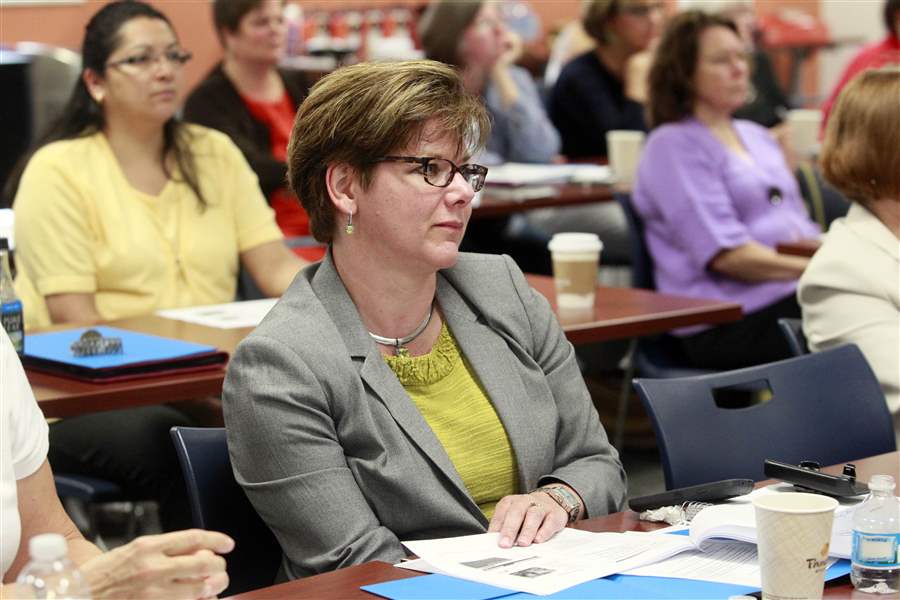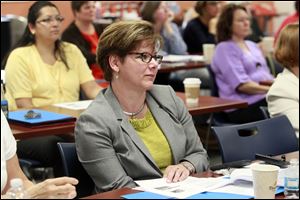
OBAMACARE ENROLLMENT
Ohio insurance market to open; turmoil abounds
Confusion, concerns over cost and access cloud Oct. 1 kickoff
9/22/2013
Jan Ruma, vice president at Hospital Council of Northwest Ohio, listens at a training session on informing citizens about health-care coverage options through the Affordable Care Act. Federal resources will play a key role in informing people, she said, and the marketplace will be mostly self-serve until assistance efforts are up and running.
THE BLADE/AMY E. VOIGT
Buy This Image

Jan Ruma, vice president at Hospital Council of Northwest Ohio, listens at a training session on informing citizens about health-care coverage options through the Affordable Care Act. Federal resources will play a key role in informing people, she said, and the marketplace will be mostly self-serve until assistance efforts are up and running.
First in an occasional series
On your marks, get set, enroll.
In just more than a week, the doors will fling open to the Health Insurance Marketplace — a key component of the Affordable Care Act that provides a place for the nation’s uninsured and others looking for coverage to search, study, and sign up for health-care plans.
Open enrollment in marketplace plans starts Oct. 1 and continues through March 31.
The contentious health-care reform package, often called Obamacare, became federal law in 2010. Despite the long buildup to the enrollment rollout, there’s plenty of confusion and no accessible way yet for people to plug in their specific information and find out exactly what their coverage would cost.
■ Marketplace Web site: www.healthcare.gov
■ Marketplace hot line telephone number:1-800-318-2596
■ Ohio Department of Insurance Web site: www.insurance.ohio.gov
■ Michigan Department of Insurance and Financial Services Web site: www.michigan.gov/difs
The marketplace, also known as health-care exchanges, will offer an assortment of insurance plans from private insurance firms. Some who forgo coverage next year may have to pay a penalty when they file their federal income tax returns. “This is a whole new world for a lot of people. Many of the folks who are going on the marketplace may never have had coverage or may not have had coverage for quite some time,” said Amy Rohling McGee, president of the Columbus-based nonpartisan organization Health Policy Institute of Ohio.
In Ohio, about 1.3 million people under the age of 65 — including about 55,000 Lucas County residents — are uninsured, according to the U.S. Census Bureau. In Michigan, roughly 1.13 million residents are uninsured.
About 916,000 Ohioans are expected to be eligible for help paying for coverage, according to Families USA, a nonprofit group that is promoting the marketplace.
The Ohio Department of Insurance approved 12 companies that offer 200 individual health insurance plans and 184 plans from six companies offering small-group health insurance options. The Centers for Medicare & Medicaid Services will release a final list of approved plans by Oct. 1, a spokesman said.
In Michigan, 13 insurers offered almost 150 individual and small-group plans for the marketplace; a final list of plans has yet to be released, according to a spokesman with the Michigan Department of Insurance and Financial Services.
Slightly more than half of those surveyed in a poll released last month by the Kaiser Family Foundation said they don’t have enough information about the health-care law to know how it affects them, and about 44 percent are confused about its status, according to the nonprofit organization that provides health-policy analysis.
“Patients are starting to ask questions about the exchange. The most common question is just, ‘What is the exchange?’ ” said Dr. Ken Bertka, chief medical officer of Mercy Medical Partners.
Getting help
For those who need help answering that question or who don’t know how to proceed, some help will be available.
But not everyone expected to provide assistance will be ready by Oct. 1.
The Toledo-based Neighborhood Health Association will receive roughly $860,000 in federal funds to educate people about the marketplace.
The association will fill nearly 30 positions, the bulk of which will be helpers, or “navigators,” to assist the public.
Chief Executive Officer Doni Miller said navigators will be at community health centers and other sites. They must complete training and be certified by the Ohio Department of Insurance.
She hopes to have navigators ready to help people “as close to Oct. 1 as we can get.”
As of late last week, the state insurance department had not received any navigator certification applications.
Officials said navigators will play an important role in helping people sign up for coverage, especially those who don’t have access to a computer, have trouble reading, or face other obstacles.
“There will be a ton of people out there who won’t have a clue how to do this and won’t have the access to do it,” Ms. Miller said.
Ohio agencies awarded federal funds to provide these services found out about their successful grants last month. That tight time line, training requirements, and uncertainty over state-specific rules made it challenging for some groups to organize quickly.
Just last week, the Hospital Council of Northwest Ohio learned it won’t be eligible to provide navigator services. The council had planned to use some funds from the Ohio Association of Foodbanks — which received the state’s largest federal grant at roughly $2 million — to pay for up to five navigators in northwest Ohio.
But because the council manages a program that includes funding from some insurers who will sell plans in the marketplace, Ohio law prohibits the council from providing navigators, council Vice President Jan Ruma said.
Toledo/Lucas County CareNet agreed to work with the program instead to provide local help.
Checking up
The food bank group’s grant will pay for up to 40 navigators to work throughout the state, Executive Director Lisa Hamler-Fugitt said. Her organization — one of several in Ohio to be awarded grants — was among some who received a letter from Republican members of the U.S. House of Representatives Committee on Energy and Commerce asking for detailed information about the grant and how it would be used.
Ms. Hamler-Fugitt sent a 124-page response plus more documentation. She said she thinks the intent of the request was to deter agencies from providing the services.
Rep. Bill Johnson (R. Marietta) was among those who signed the letter, sent shorty after the grant was announced. His spokesman said he did so because he wants to know where the federal money is going and how it’s being used as a matter of “general oversight.”
‘Self-serve’
Federal resources will play a key role in informing people, and the marketplace will be mostly “self-serve” in October until local assistance efforts are up and running, Ms. Ruma said.
The Web site www.healthcare.gov and a telephone hot line will help consumers enroll in marketplace plans. Insurance brokers and agents and other community groups also can offer various levels of help with the application process, said Trey Daly, the Cincinnati-based Ohio state director for Enroll America. The nonprofit group is telling uninsured residents about the marketplace by going door-to-door, making phone calls, and canvassing at events.
Mr. Daly visited Toledo recently to speak to a group of roughly 60 people who work with local health-care providers, insurers, and representatives of community agencies.
ProMedica, Mercy, and the University of Toledo Medical Center, the former Medical College of Ohio, have financial counseling services and will offer marketplace information for uninsured patients.
Down to details
Michigan and Ohio residents will use a federally run exchange to compare plans and enroll in coverage.
Starting Oct. 1, insurance shoppers can go online to enter their information and review options in a format that might feel familiar to those who have used Web sites to buy flights or other goods and services.
The marketplace will allow people to check if they qualify for tax credits to defray the cost. Those with incomes that fall between 100 and 400 percent of the federal poverty level, or $45,960 for an individual and $94,200 for a family of four, may qualify for tax credits.
A plan’s price tag can depend on age, tobacco use, where you live, and number of people covered. But, beginning in 2014, those with pre-existing conditions can’t be refused coverage or charged more for insurance.
People can choose from four, color-coded coverage levels. Platinum-level plans feature pricier monthly premiums and lower out-of-pocket costs, while a bronze plan means paying a smaller premium but shouldering more of the cost when receiving care.
All plans must cover, at a minimum, the same “essential benefits,” services that include hospitalization, mental health care, maternity care, and prescription drugs.
A 21-year-old, nonsmoking Lucas County resident who chooses one silver-level plan offered by HealthSpan, an insurer owned by Catholic Health Partners, would pay a monthly premium of $203.57. A 43-year-old on the same plan would have a $276.24 monthly premium, and a 64-year-old would have a $610.89 premium, according to rates provided by HealthSpan. Depending on their income, those plan buyers could be eligible for tax breaks to lower the cost.
Those who receive Medicare, the government insurance program for people age 65 and older and those with certain disabilities, don’t need to enroll in the marketplace.
Medicaid
Those who receive Medicaid, health coverage based on factors such as family size and income, also don’t need to enroll in a marketplace plan.
Ohio has yet to decide on expanding Medicaid to cover those earning up to 138 percent of the federal poverty level. Michigan agreed to expand the program. Without expansion, some low-income Ohioans, many of whom are people without dependent children, would fall through coverage cracks and not receive subsidies for marketplace plans or qualify for Medicaid, according to the Health Policy Institute of Ohio.
Employer plans
Those who have health insurance through a job also don’t need to enroll in a marketplace plan. Some with employer-sponsored insurance may choose to check out marketplace options but may not be eligible for subsidies if their workplace plan is considered affordable.
About 51 percent of Ohioans have employer-sponsored coverage. About 14 to 15 percent have Medicare, about the same percentage of those with Medicaid, and 5 percent purchase insurance on their own, according to the Health Policy Institute of Ohio.
Those without insurance in 2014 may have to pay a penalty, a fee that jumps each year. Next year, the fee amounts to the greater of 1 percent of one’s annual income or $95 a person. The fee may be waived for religious reasons, for those who can’t afford coverage, and for those who lack coverage for less than three months, among other possible exemptions.
Initial interest
No one knows for certain whether Oct. 1 will bring a stampede or a trickle of traffic to the marketplace.
Some are preparing for a rush of activity in early October. Michigan Consumers for Healthcare, the group to receive the biggest navigator grant in Michigan, is “readying for an onslaught,” Executive Director Don Hazaert said.
Others, such as Ms. Miller, expect a slow start that revs up after local groups have trained helpers to educate and assist consumers.
“I think everybody is totally confused. Remember, there has not been any widespread release of information to the public as to how they should be expected to respond,” she said.
Contact Vanessa McCray at: vmccray@theblade.com or 419-724-6056, or on Twitter @vanmccray.